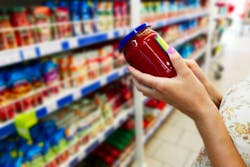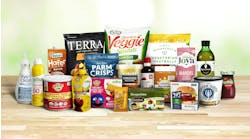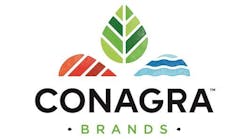After 31 consecutive months of dollar sales growth, including double digit gains in 12 of them, private label/store brands experienced their first negative month, as even dollar sales declined 0.8% for the period ending Nov. 5, 2023.
Until then, private label was chipping away at the market share of the major brands. For the past year, private label sales were mirroring those of the brands: dollar sales up while volume declined. But the October figures were a bit surprising, even to the manufacturers of these products.
“We’ve seen store brands' increases in dollar sales trend down from double to single digits over the past several months,” explains Peggy Davies, president of Private Label Manufacturer Assn. (www.plma.com). "Store brands rang up 31 straight months of dollar sales growth from June 2021 to October 2023, an unprecedented performance. For thirteen consecutive months from April 2022 to February of this year, the growth was in double digits, with an average monthly gain during that period of more than 12%."
Ironically, the sales dip occurred about the same time as PLMA’s 2023 Private Label Trade Show. A record 1,685 exhibitors showcased new products, flavors, packaging, ingredients and services in the Nov. 12-14 expo in suburban Chicago. There were more than 13,000 attendees, many of them retailers looking for products to add to their store brand.
While private label always has been dominated by smaller manufacturers with just a few specialties each, past shows have included a few billion-dollar companies. This year there was no TreeHouse Foods – which is undergoing a multi-year reorganization – and in the past Conagra and Post Foods have had significant private label manufacturing operations (Post still does).
“Private label is doing well, the snack categories in particular,” Tyler Cook of Shearer’s Foods (www.shearers.com) said from his booth on the show floor. “There’s arguably a tightening economy, and private label has a key role to play in that.”
SunOpta agrees. “A lot of consumers have been trying it [private label] for the first time. They know the value is there, it always has been, but when they see the quality is there, too, they come back,” adds Lauren McNamara, vice president of the company’s plant-based food & beverage business (www.sunopta.com). “They also look for innovation, what’s new and what’s next, and private label manufacturers are stepping up.”
Some of the product trends apparent on the show floor:
- Plant-Based Power – To elevate the plant-based dining experience, manufacturers are offering new options in ethnic meals as well as convenient handheld snacks: beefless Korean bulgogi, porkless carnitas, plant-based butter “chik’n” and alternative chicken fries, fish sticks and mozzarella bites.
- Spicy Snacks – The global shift to spicy food options has found its way into the snack aisle, which is heating up with new flavor combinations featuring jalapeno, chili, habanero and other spicy peppers: jalapeno cheddar trail mix; habanero pork rinds; spicy jalapeno sweet potato chips; habanero nacho sweet potato chips; and pineapple habanero honey roast sesame sticks.
- Tropical Tastes – The popularity of plant-based diets coupled with increasing awareness about health benefits of coconut are driving growth of coconut-based baked goods, snacks and beverages: Coconut water, coconut chips, coconut sugar, coconut pet treats, coconut flour and ube-filled coconut rolls.
- Global Suppliers – There was a strong global presence at the show: More than 45% of the exhibit floor – about 760 exhibitors – was filled with food and nonfood suppliers from outside the U.S., including 40 country pavilions, such as Australia, Belgium, Brazil, Canada, Chile, China, Colombia, Denmark, Estonia, France, Georgia, Greece, Guatemala, Italy, Japan, Jordan, Lithuania, Peru, Republic of Serbia, South Africa, South Korea, Spain, Thailand, Turkey, Ukraine and the United Kingdom.
Even with the October dip, PLMA projects total U.S. store brand dollar sales for 2023 will reach $233 billion, an increase of about $4 billion over 2022, based on Circana data. Food & beverage represents the biggest share of private label figures, but the category includes general merchandise, home care/cleaning products and health & beauty.
Banking on Gen Z
Generation Z, sometimes referred to as Zoomers, is the demographic group born between the mid-to-late 1990s and about 2010. As such, many are just entering adulthood and becoming a key food shopping factor. A lot of marketers have their sights on them.
More than half of Gen Z grocery shoppers “always/frequently” choose a place to shop due to its store brands, according to a new PLMA consumer research report titled “Gen Z Loves Store Brands: America’s Youngest Consumers Speak Out on Grocery Shopping, Stores and Brands.”
In the survey, 67% of Gen Z shoppers say they are “extremely/very” aware of store brands; 64% say they buy store brands “always/frequently;” 56% are “extremely likely/likely” to experiment with store brands to find “best value;” and 51% say they “always/frequently” choose a place to shop due to its store brands.
Among other findings:
- 53% of Gen Z say "Valuable" describes store brands "precisely/very much."
- 52% of Gen Z say "Reliable" describes store brands "precisely/very much."
- 50% of Gen Z say "Variety" describes store brands "precisely/very much."
“Gen Z store brand purchase frequency is most strongly driven by a perception that store brands are 'reliable,’” Sara Williamson, assistant professor of marketing at SUNY Old Westbury, told an audience at the November trade show. “Reliability perception is a stronger store brand purchase predictor than any other measure, including household income and monthly grocery spending."
The impact of store brand reliability is a solid indicator that the manufacturer-retailer relationship is more important than ever, she said. “To succeed with Gen Z, retailers must establish a foundation of store brand suppliers who meet their customers' quality expectations," she added.
“Gen Z consumers especially are driving our sales,” Rasa Kumar, senior vice president of ADF Foods (www.adf-foods.com) said from her booth at the show. The India-based company claims to be the world’s biggest producer of samosas, making 300,000 a day by hand, then freezing them and exporting them all over the world.
“Gen Z is epicurious, interested in all ethnic cuisines, but country of origin and authenticity matters,” she continues. “A lot of our ethnic offerings [the company also makes Middle Eastern, Mediterranean and Korean products] have traditionally been plant-based.”
Perhaps the big brands hold one advantage over these mostly smaller private label manufacturers. “Luckily, as they play for 2024, CPGs [consumer packaged goods suppliers] can become more competitive against private label by leveraging AI capabilities,” says Brooke Hodierne, executive vice president of strategy consulting at Insite AI (insite.ai), an artificial intelligence consulting group.
She points out some advantages AI can deliver to the bigger CPG companies, including:
- Data-driven decision making – AI harmonizes data in a digestible way, improving decision making to best serve specific shoppers.
- Forecasting – CPGs can look ahead and receive granular reports that explain exactly how a certain product will perform at a certain price point and in a certain customer segment, including Gen Z.
- Optimization – AI models can ingest a CPG’s specific goals, such as revenue or share of space next to the private labels, and then it can run scenarios to determine the optimal assortment, pricing and more.



